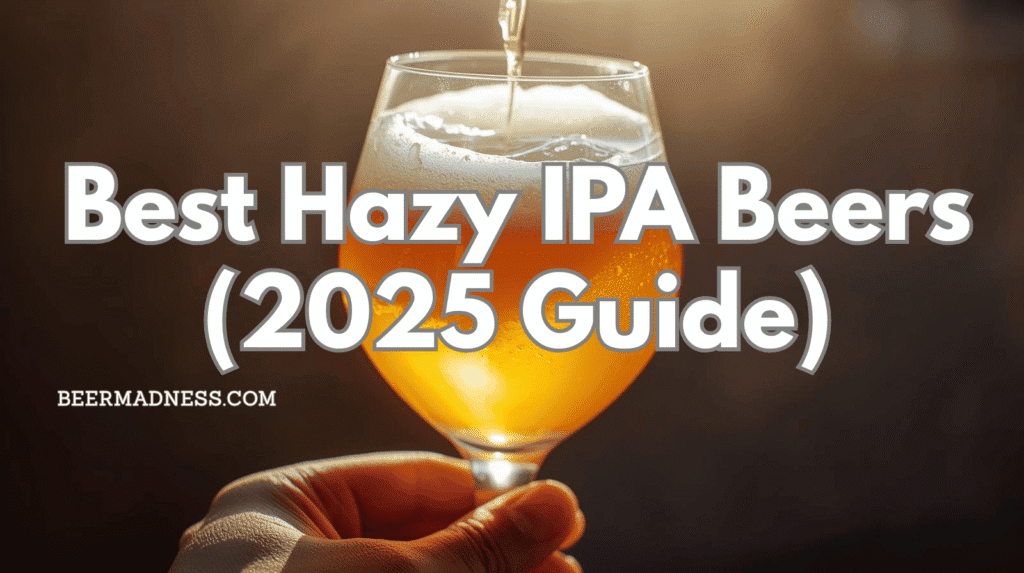There’s something magical about that first pour of a Hazy IPA — a soft golden haze swirling in the glass, aromas of mango, citrus, and peach bursting out before the first sip even touches your lips. It’s juicy, pillowy, and impossibly fresh. No wonder this cloudy, flavour-packed beer style has become one of the most beloved in modern craft brewing.
In this guide, we’ll explore the best hazy IPA beers you can find in 2025 — from iconic trailblazers to small-batch UK gems that push the style in new directions. You’ll learn what makes hazy IPAs so irresistible, how to spot a great one, and where to find the freshest examples across the UK and Europe.
But first, what exactly makes an IPA hazy — and why are drinkers obsessed with its juicy, fruit-forward flavour? The answer lies in a perfect storm of science and artistry: unfiltered grains, generous dry-hopping, and a brewing philosophy that prizes softness over sharpness.
According to Stone Brewing, the haze in hazy IPAs comes from a mix of grain proteins, hop oils, and polyphenols — natural compounds that remain suspended in the beer. Unlike traditional IPAs, which aim for clarity, hazy IPAs embrace this cloudiness as a symbol of freshness and full-bodied flavour.
Whether you’re a longtime hophead or just discovering the juicy revolution, this article will be your tasting compass — guiding you through the history, characteristics, and our hand-picked list of the best hazy IPA beers to try right now.
What Is a Hazy IPA?
To understand why hazy IPAs have taken over tap lists worldwide, we first need to decode what this style truly represents. A Hazy IPA — often called a New England IPA (NEIPA) or Juicy IPA — is a softer, fruit-forward interpretation of the classic India Pale Ale.
Instead of the crisp bitterness and crystal clarity of West Coast IPAs, hazies celebrate tropical aroma, smooth texture, and visual opacity — the kind of beer that looks like a glass of liquid sunshine.
A Style Defined by Its Haze
The signature cloudiness isn’t an accident; it’s a deliberate outcome of the ingredients and brewing method.
- Oats and wheat add proteins that create body and haze.
- Late-stage dry-hopping infuses the beer with juicy aroma while keeping bitterness low.
- Unfiltered fermentation leaves natural compounds suspended, giving that glowing, misty look.
According to Sierra Nevada Brewing Co., the haze is caused by “a combination of proteins from the grains and polyphenols from hops that bond together.” The result is a creamy, smooth beer packed with layers of fruit-forward hop flavour.
Origins in New England
The style traces its roots to Vermont in the early 2010s. Breweries like The Alchemist (famous for Heady Topper) and Tree House Brewing Co. challenged the dominance of bitter, clear IPAs by crafting something softer, juicier, and intentionally opaque.
That first pour of Heady Topper — bursting with orange and pineapple aroma — changed expectations forever. Soon, other New England brewers followed suit, and the haze craze began its global journey.
Beyond the Look: A Sensory Experience
A great hazy IPA is all about balance:
- Appearance: Opaque, golden-orange, with a soft white head.
- Aroma: Mango, peach, citrus, and tropical fruit.
- Flavor: Low bitterness, juicy hop character, hints of sweetness.
- Mouthfeel: Silky, pillowy, medium-full body with gentle carbonation.
The best hazy IPA beers don’t just look beautiful — they feel beautiful to drink. They wrap the palate in fruit and freshness rather than bite and bitterness. That smooth character is what makes this style approachable for newcomers and endlessly fascinating for seasoned craft-beer fans.
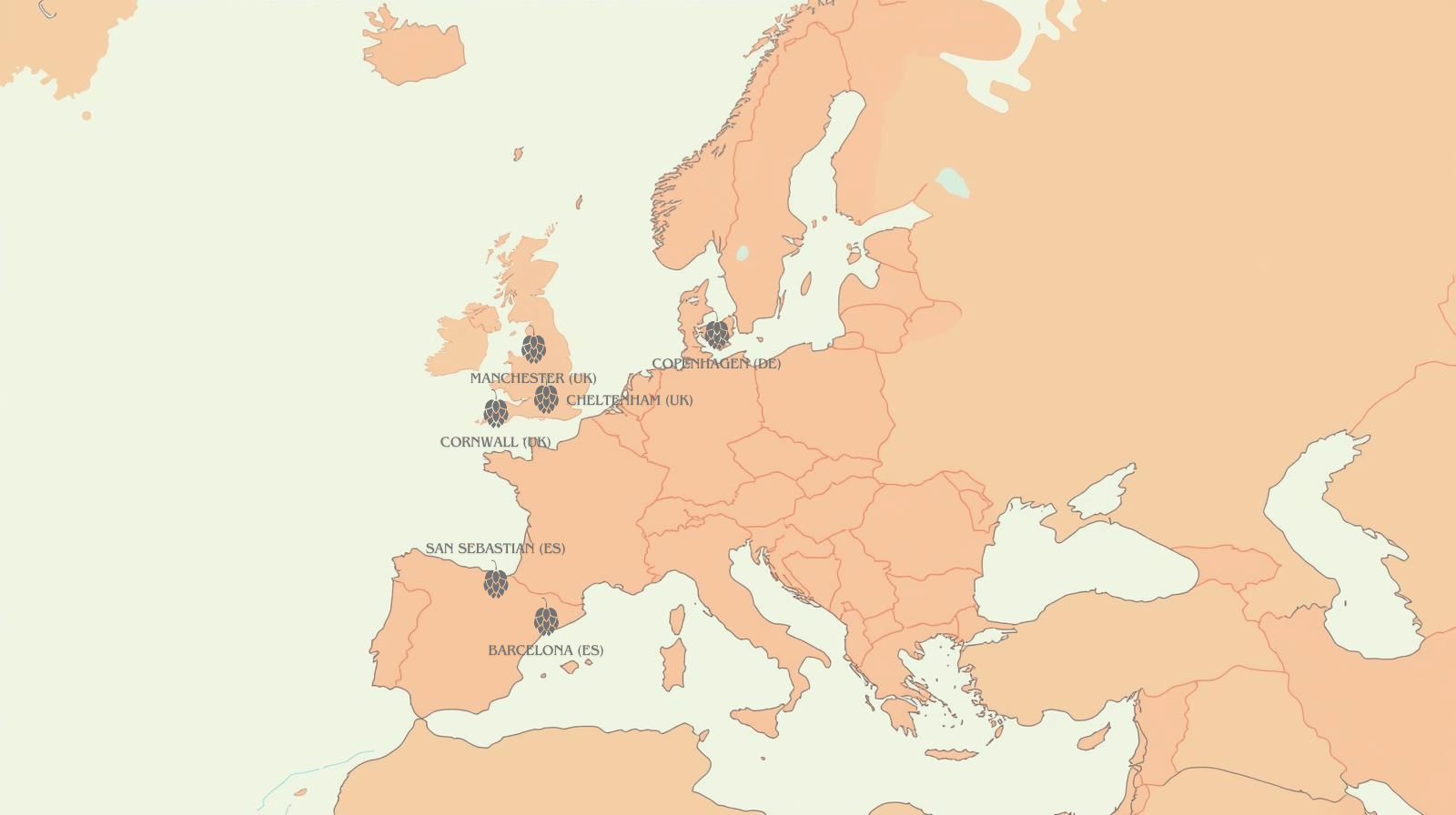
Why Hazy IPAs Became So Popular
When hazy IPAs first started appearing on tap lists, many brewers dismissed them as a passing fad — a curious, cloudy alternative to the sharp West Coast style. But within a few years, they had transformed the craft beer landscape. Today, it’s hard to find a brewery that doesn’t produce at least one. So what exactly fueled this haze craze?
1. A Softer, More Approachable IPA
For years, traditional IPAs were known for their assertive bitterness — the kind that could make newcomers wince. Hazy IPAs flipped that script.
They traded bitterness for aroma, clarity for texture, and turned hops from a sharp edge into a juicy embrace.
According to Firestone Walker Brewing Co., the hazy style “focuses on the fruit-forward, low-bitterness side of hops,” making it more inviting for casual drinkers and experienced hopheads alike.
This softer balance opened the door for people who previously found IPAs too aggressive — expanding the audience for craft beer itself.
2. A Visual and Sensory Revolution
The haze wasn’t just flavour innovation — it was visual marketing.
That glowing orange opacity looked different from anything else on the shelf.
Pour a hazy IPA next to a clear lager or pale ale, and you instantly notice its creamy body and juice-like appearance.
The rise of Instagram and visual beer culture in the mid-2010s amplified this appeal.
Each can release became an event: limited runs, colourful labels, and photogenic pours.
The haze wasn’t just haze — it was a badge of freshness, a signal that your beer had been crafted with maximum hop aroma in mind.
3. Breweries Embraced Experimentation
Hazy IPAs gave brewers a creative playground.
Without the need for crystal clarity or standardized bitterness, they could push boundaries — experimenting with new hop varieties, multiple dry-hop stages, and even fruit additions.
This flexibility accelerated innovation in hop farming and brewing science.
Modern hop strains like Citra, Mosaic, Galaxy, and Nelson Sauvin became household names among beer lovers, prized for their tropical complexity.
The Brewers Association officially added “Juicy or Hazy IPA” as a recognized style category in 2018, solidifying its place in beer history.
4. It’s the Flavor of Freshness
Unlike traditional IPAs, hazy IPAs are meant to be enjoyed fresh — ideally within a few weeks of packaging. This emphasis on immediacy created a sense of excitement and urgency.
Fans started chasing can releases, brewery drops, and tap takeovers just to taste the newest batch.
In a world obsessed with the “next thing,” hazy IPAs provided exactly that: a perpetual new experience in every pour.
5. Global Influence
What began in Vermont quickly spread across the Atlantic.
UK breweries like Cloudwater, Verdant, and Deya adapted the New England style with their own twist — often combining British malts with new-world hops.
European craft brewers followed, from Scandinavia to Spain, each adding local character to the haze revolution.
Today, the best hazy IPA beers in the UK and Europe rival their American counterparts in creativity and flavour.
The haze isn’t just a style anymore — it’s a movement, a shared language among brewers who prize aroma, balance, and drinkability over clarity and bitterness.
Style Profile – What to Look For in the Best Hazy IPA Beers
If you want to recognize a world-class hazy IPA, you don’t need to be a certified beer judge — you just need to know what to look, smell, and taste for. The best hazy IPA beers share a few unmistakable qualities: visual depth, soft mouthfeel, juicy hop character, and an aroma that leaps from the glass before you even take a sip.
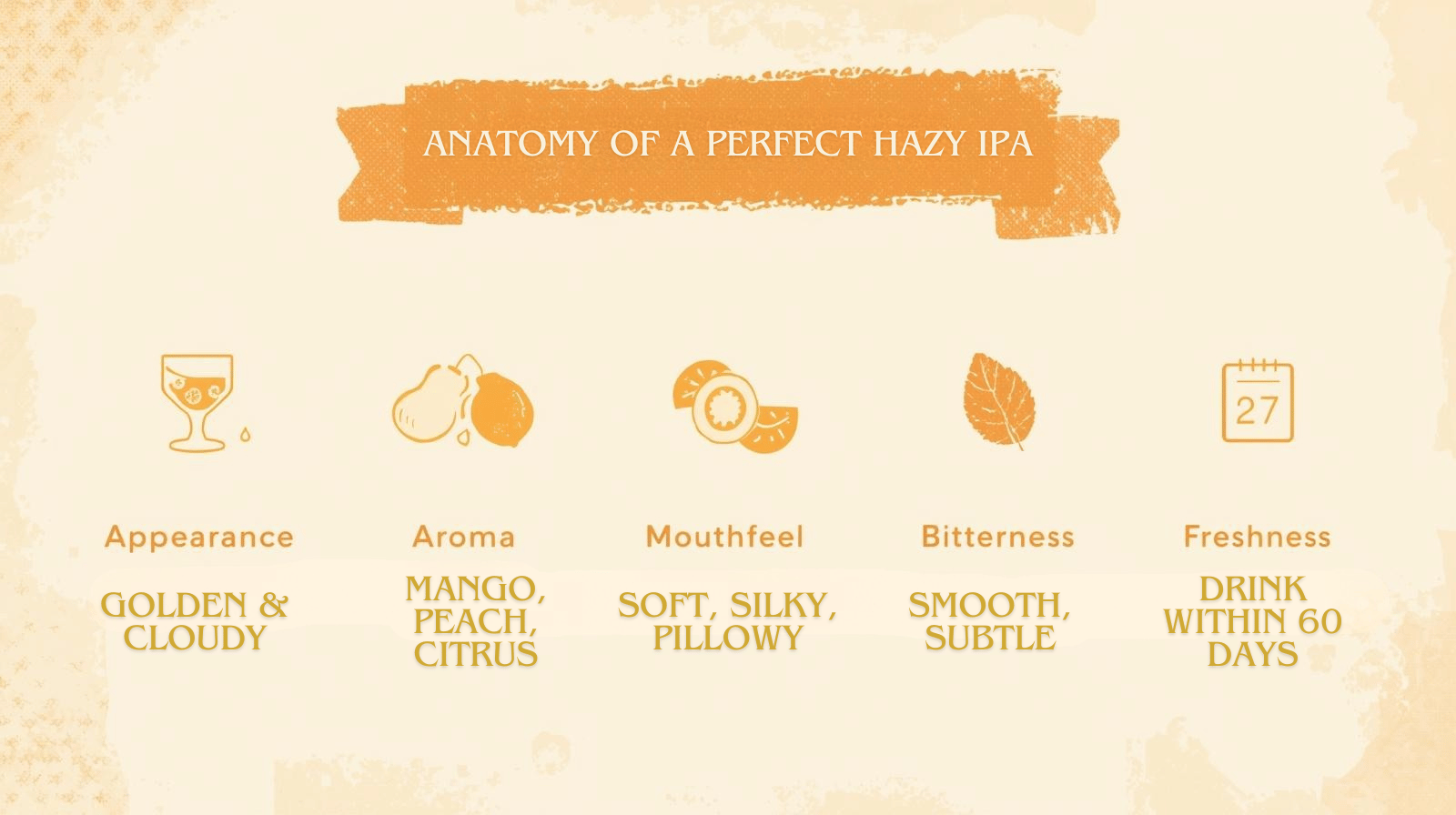
Let’s break down the essential traits that define the style.
1. Appearance: A Clouded Glow
The first clue is in the pour.
A hazy IPA should look like golden-orange juice kissed by sunlight — dense but inviting, opaque yet glowing.
You might see a fluffy, white head that lingers, leaving rings of lace down the glass as you drink.
This haze comes from a deliberate brewing choice. Brewers use grains like flaked oats and wheat, which release proteins that stay suspended in the beer, and late dry-hopping that adds hop oils and polyphenols.
According to Sierra Nevada Brewing Co., “Haze is created by a combination of proteins from the grains and polyphenols from hops that bond together.”
In short: the haze isn’t a flaw — it’s a feature.
2. Aroma: Bursting with Fruit and Freshness
The nose of a great hazy IPA is its calling card.
Expect lush waves of tropical fruit — mango, peach, guava, orange, passionfruit — layered with light pine, citrus zest, or white wine notes depending on the hops.
This intensity comes from massive late-hop additions and dry-hopping after fermentation. Instead of bitterness, you get aromatic oils preserved in their freshest form.
Modern hop varieties like Citra, Mosaic, Galaxy, Sabro, and Nelson Sauvin dominate this space, each contributing unique fruit characteristics.
A true hazy IPA should smell like a fruit basket freshly torn open — vivid, fragrant, and mouthwatering.
3. Flavor: Juicy, Soft, and Harmonious
The best hazy IPA beers deliver what their aroma promises: a rounded, juicy hop profile with minimal bitterness.
You might taste orange juice, ripe peach, or even melon — but without the sharp bite of a traditional IPA.
That’s because hazy IPAs rely on biotransformation, where yeast interacts with hop compounds during fermentation to release new fruity esters.
This scientific magic turns hops into flavor complexity.
As Firestone Walker Brewing Co. explains, hazy IPAs “highlight the tropical, citrusy notes of hops through late additions, creating flavor without aggression.”
4. Mouthfeel: Pillowy and Silky
Texture matters. A hallmark of the hazy IPA is its soft, almost creamy mouthfeel.
This is achieved through the combination of protein-rich grains (oats and wheat) and the absence of heavy filtration.
The result? A beer that feels smooth on the tongue, often described as “pillowy” or “velvety.”
Carbonation tends to be moderate — enough to lift the flavors but never harsh.
When done right, the beer coats your palate in tropical sweetness, fading gently into a clean, refreshing finish.
5. Bitterness: Balanced and Backgrounded
Unlike the resinous punch of a West Coast IPA, bitterness in hazy IPAs should be restrained — typically around 20–50 IBU.
Brewers achieve this by moving hop additions later in the brewing process, emphasizing flavor and aroma over alpha acid extraction.
The bitterness is still there, but it plays in harmony rather than dominating the experience.
6. Freshness: The True Test of Quality
Perhaps the most important quality in any hazy IPA is freshness.
Hop aroma and volatile oils fade rapidly with time and exposure to oxygen.
A great hazy should smell and taste alive — bursting with energy.
Always check the canning date and look for beers that are less than two months old.
As BeerAdvocate reminds drinkers, hop-forward beers “are best enjoyed as fresh as possible — that’s when the hop aroma and flavor are at their peak.”
If the beer’s gone dull, the haze won’t save it.
7. The “It” Factor: Balance Between Fruit, Cream, and Flow
All technical markers aside, there’s one intangible quality that makes a hazy IPA truly memorable — balance.
It should be juicy but not sugary, smooth but not heavy, aromatic yet drinkable.
That harmony between fruitiness, creaminess, and flow is what separates a forgettable haze from one of the best hazy IPA beers you’ll ever taste.
How We Selected the Best Hazy IPA Beers (2025 Criteria)
There’s no shortage of hazy IPAs on the market — from limited taproom-only releases to supermarket standouts.
So when we set out to create this guide to the Best Hazy IPA Beers of 2025, we wanted to do it right.
No hype. No random ranking. Just real, taste-driven evaluation based on freshness, balance, and character.
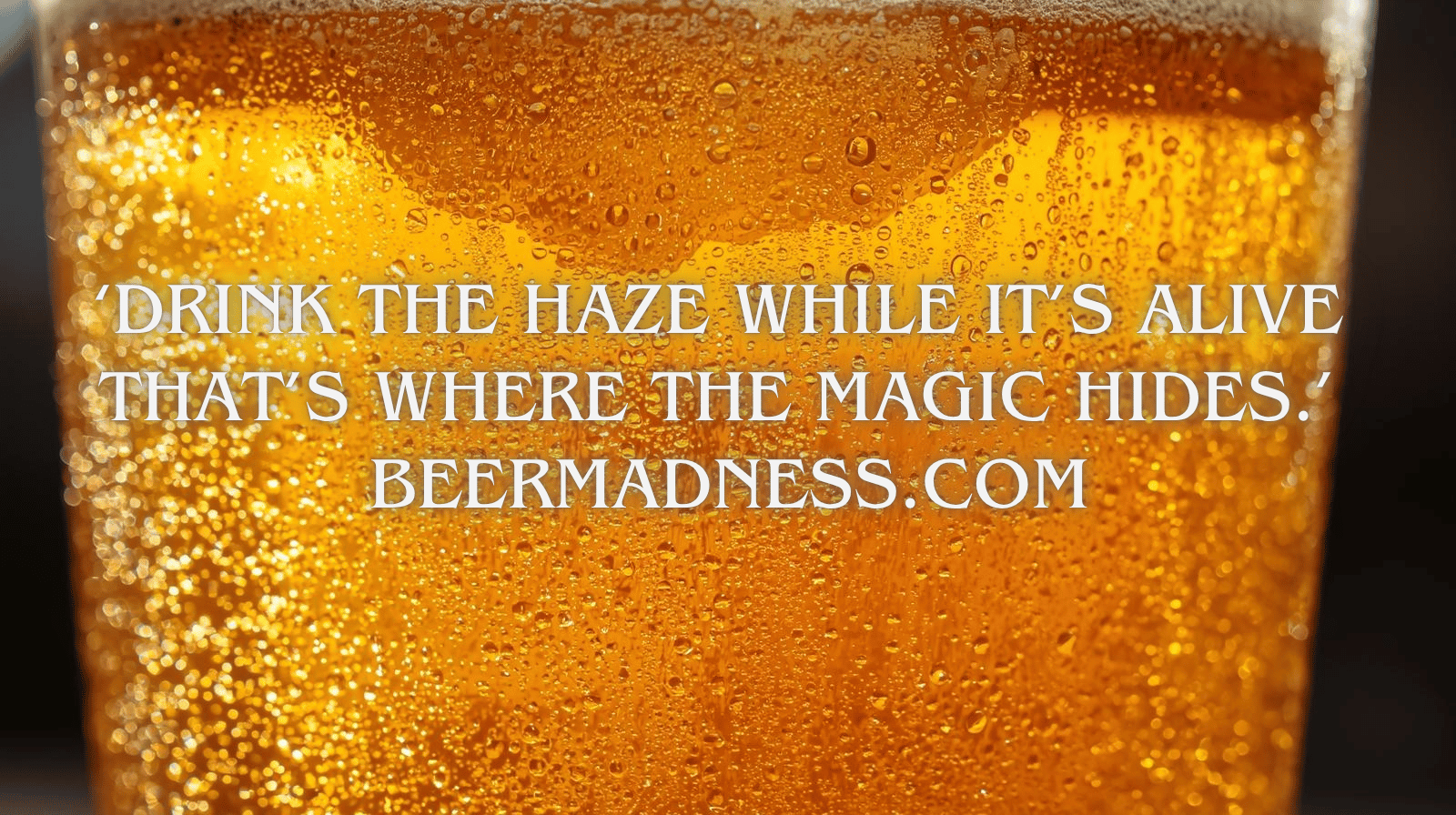
Here’s how we approached our list.
1. Freshness First
The soul of a hazy IPA lives in its aroma — and aroma fades fast.
That’s why our first rule was simple: every beer considered had to be freshly canned or bottled, ideally within 60 days of sampling.
We excluded any product past its prime, since hazy IPAs deteriorate quickly once oxygen or light gets involved.
According to BeerAdvocate, “Hop-forward beers should be enjoyed as fresh as possible — that’s when the hop aroma and flavor are at their peak.”
We couldn’t agree more.
2. Availability and Accessibility
Beer lists are most useful when readers can actually find the beers mentioned.
So while we love rare taproom exclusives, we focused on hazy IPAs that are available in the UK and Europe — either through reputable craft retailers, brewery webshops, or recurring seasonal releases.
This ensures the beers on our list aren’t just delicious; they’re within reach for most readers.
It’s about celebrating accessibility without sacrificing quality.
3. Consistency and Reputation
Consistency separates a lucky batch from a truly great beer.
We only included breweries with a proven record of delivering quality across multiple releases — brands whose commitment to the style is evident in every pour.
Whether it’s Cloudwater’s soft, balanced approach, Verdant’s juicy intensity, or Track Brewing Co.’s refined hop layering, these producers have earned their reputations.
All selections were cross-checked with aggregated ratings from sites like Untappd, ensuring that public reception aligned with our own tasting impressions.
4. Style Accuracy and Innovation
The best hazy IPA beers don’t just look the part — they embody the essence of the style: aroma-forward, low bitterness, and irresistibly drinkable.
But we also rewarded creativity. Some brewers are experimenting with adjuncts like passionfruit, coconut, or lactose, creating substyles such as milkshake hazy IPAs.
We considered these innovations valid when they enhanced the experience rather than overwhelmed it.
5. Balance and Drinkability
It’s easy to chase extremes — ultra-hazy, super-hopped, or high-ABV beers — but the finest examples remain balanced and approachable.
We prioritized beers that combine depth of flavour with smooth, clean finishes.
They should make you want another sip, not just another photo.
6. Local Perspective, Global Standard
While our focus is on UK and European availability, we benchmarked every selection against global standouts — icons like Heady Topper (The Alchemist) and Julius (Tree House Brewing Co.), which continue to set the standard for haze and flavor integration.
This ensures the beers featured here stand shoulder to shoulder with the world’s best.
7. BeerMadness Integrity
Finally, all selections were made independently — no brewery sponsorships, affiliate incentives, or promotional considerations.
BeerMadness exists to serve readers, not brands.
We believe the craft beer world thrives when reviews remain honest, transparent, and rooted in genuine passion for the pint.
In the end, our list of the Best Hazy IPA Beers of 2025 represents more than just what’s trending — it’s a curated collection of beers that express the artistry, freshness, and joy of the haze movement.
Each one has earned its place not because it’s popular, but because it’s worth pouring again.
The Top Hazy IPA Beers to Try in 2025
Choosing the best hazy IPA beers isn’t about hype — it’s about finding that perfect meeting point between aroma, texture, and drinkability.
From Vermont icons to UK innovators, these ten picks capture what makes the haze craze so enduring: lush fruit character, soft mouthfeel, and pure freshness.
Each has been selected for flavour excellence, consistency, and accessibility in the UK & Europe.
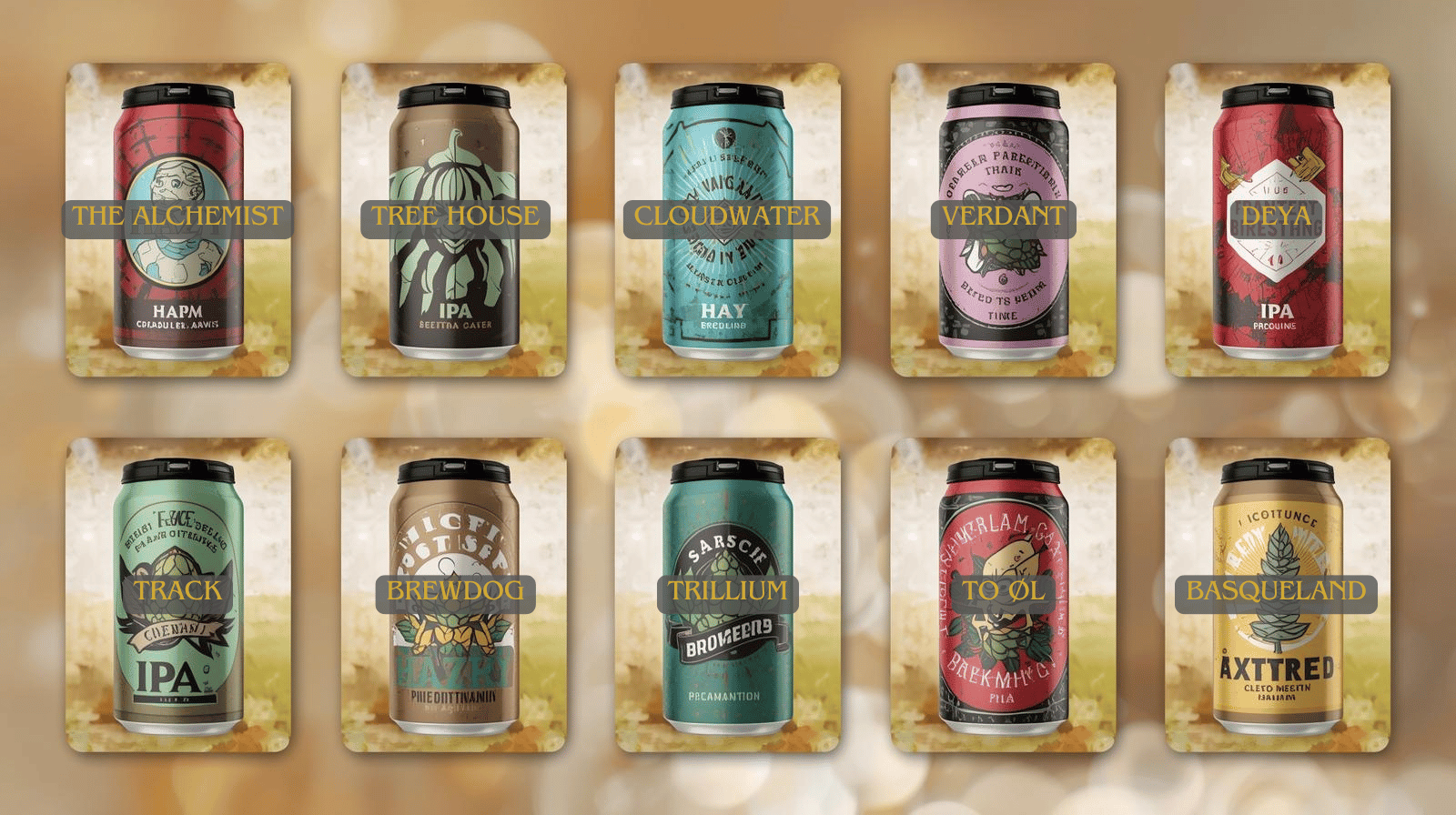
1. Heady Topper — The Alchemist (Vermont, USA)
ABV: 8% Availability: Limited import (UK specialist retailers)
This is where it all began. First brewed in 2011, Heady Topper remains the benchmark for the style — a riot of orange, mango, and pine with a silky, balanced body.
Its haze is unfiltered authenticity, not aesthetic. As The Alchemist notes, the goal was never to chase haze — it was simply to “pack as much hop aroma and flavour as possible into every can.”
2. Julius — Tree House Brewing Co. (Massachusetts, USA)
ABV: 6.8% Availability: Limited import / collaboration releases
A juicy legend. Julius glows a hazy gold and bursts with tangerine, peach, and papaya aromas. It’s the beer that made “New England IPA” a global phrase.
Soft carbonation and gentle sweetness make each sip seamless — the template for every modern hazy that followed.
3. Cloudwater IPA v15 — Cloudwater Brew Co. (Manchester, UK)
ABV: 6.5% Availability: UK & EU retailers
Few breweries have defined the British haze era like Cloudwater. The v-series IPAs evolve constantly, showcasing hop innovation with each batch.
Version 15 leads with Mosaic and Citra hops, offering pineapple and grapefruit notes wrapped in Cloudwater’s signature smooth texture.
4. Headband — Verdant Brewing Co. (Cornwall, UK)
ABV: 5.5% Availability: UK core range
Verdant’s Headband shows that not all great hazy IPAs need double-digit ABV.
Juicy mango, apricot, and a light piney bite keep it balanced, while oats give it a silky, gentle mouthfeel. It’s approachable, fresh, and endlessly drinkable — a British classic.
5. Sonoma — Track Brewing Co. (Manchester, UK)
ABV: 3.8% Availability: UK core range / cask and can
A low-ABV hazy pale that proves session strength doesn’t mean sacrificing flavour.
Expect grapefruit zest, mango flesh, and a creamy texture that belies its modest alcohol level.
Track’s philosophy of “balance and brightness” shines through every pour.
🌤️ Craving That Juicy Haze?
Bring the Best Hazy IPA Beers from the article straight to your glass — fresh, tropical, and ready to pour:
- 🍊 Beers of Europe – explore juicy NEIPAs, DDH hazies & smooth session IPAs
Drink Fresh • Stay Hazy • Support Craft — discover your next juicy favourite today.
6. Hazy Jane — BrewDog (Scotland, UK)
ABV: 5% Availability: Global distribution
Love them or not, BrewDog helped mainstream the haze. Hazy Jane is their flagship juicy IPA, loaded with pineapple, guava, and citrus peel.
While craft purists debate its “macro-hazy” status, its accessibility has introduced thousands to the style.
7. Juice Machine — Tree House Brewing Co. (Massachusetts, USA)
ABV: 8.2% Availability: Occasional collabs / imports
A turbo-charged cousin of Julius. Huge tropical fruit character (think mango smoothie with hop fizz) meets soft carbonation and a deceptively clean finish.
When fresh, it’s electric — one of the juiciest hazy double IPAs on Earth.
8. Double Dipa — Deya Brewing Co. (Cheltenham, UK)
ABV: 8% Availability: Seasonal release
Deya’s flagship double IPA remains a benchmark for UK haze.
Massive Mosaic and Simcoe hop aroma delivers mango purée and orange pith over a creamy oat-based body.
Fresh cans sell out fast, and for good reason — it’s juicy elegance in liquid form.
(Outbound reference: Deya Brewing Co.)
9. Sleeper Street — Trillium Brewing (Boston, USA)
ABV: 7% Availability: Occasional UK import
Trillium’s signature single IPA balances brightness with body.
Expect ripe peach, lime, and a soft bitterness that fades into vanilla-oat smoothness.
It’s a masterclass in controlled intensity — proof that simplicity often wins.
10. Tasty Juicy IPA — To Øl (Belgium / Denmark)
ABV: 6.2% Availability: EU wide
Scandinavian precision meets tropical flair. Tasty Juicy delivers papaya, mango, and white grape on a fluffy oat base.
To Øl’s consistency and creative use of hops make this one of the best continental examples available year-round.
Honourable Mentions
Because haze never sleeps:
- Polly’s Brew Co. – Riwaka IPA (Wales) – bright citrus and grassy aromatics.
- Northern Monk – Patrons Project series – collab-driven hazy experiments.
- Sureshot – Small Man’s Wetsuit (Manchester) – dense body, passionfruit twist.
Each shows how far the style has travelled — and how inventive the UK scene remains in 2025.
The Big Picture
What unites these beers isn’t marketing or geography; it’s balance.
Every pour represents that elusive harmony of haze, hops, and heart — proof that the Best Hazy IPA Beers of 2025 are about craftsmanship, not cloudiness.
Whether you’re chasing the legends from Vermont or exploring new British haze heroes, freshness and flavour should always guide your pour.
Honourable Mentions & Emerging Hazy IPAs
The haze never stands still. While the Best Hazy IPA Beers of 2025 represent the style’s perfected forms, the next wave of brewers is already pushing boundaries — experimenting with new hop varieties, yeast strains, and even fruit infusions.
Here are a few standout names and trends to keep an eye on.
1. Northern Monk – Patrons Project Series (Leeds, UK)
Northern Monk’s Patrons Project collaborations bring artists, photographers, and international brewers together to craft one-off hazies with flair.
Expect anything from oat-heavy double IPAs to lactose-smoothed milkshake versions bursting with passionfruit or pineapple.
Each release feels like a creative canvas — an ongoing dialogue between art and beer.
2. Polly’s Brew Co. (Wales, UK)
Polly’s continues to refine its “modern hoppy ale” identity with an unfiltered glow and vivid aroma.
Their small-batch hazies — like Riwaka IPA and Spectrum — showcase zesty citrus, gooseberry, and gentle pine.
They’re proof that UK brewers are mastering the balance of fruit and freshness once thought exclusive to New England.
3. Basqueland Brewing (San Sebastián, Spain)
Spain’s Basqueland has quietly become one of Europe’s haze leaders.
Their AUPA IPA and Mucho Mango offer bold tropical fruit balanced by Mediterranean restraint.
Basqueland proves that the hazy revolution transcends climate and culture — great hops speak a universal language.
4. Whiplash Beer (Dublin, Ireland)
Whiplash combines the Irish tradition of malt finesse with modern hop science.
Body Riddle and Rollover deliver grapefruit, white peach, and subtle herbal depth in a trademark soft, creamy texture.
They’re perfect examples of European craftsmanship adapting New England softness into its own dialect.
5. Garage Beer Co. (Barcelona, Spain)
From its iconic “Garage Door” logo to its obsession with freshness, Garage Beer Co. consistently releases expressive hazies.
Citra Escalator and Soup have become continental cult favourites, often selling out in days.
Expect layers of melon, papaya, and lemon curd wrapped in that tell-tale soft haze.
6. The New Frontiers of Haze
Beyond regional names, the hazy IPA scene continues to evolve through exciting techniques and cross-genre creativity:
- Cryo Hops & Phantasm Powder: Using concentrated hop products and Sauvignon Blanc grape skins to boost aroma intensity.
- Yeast Innovation: Brewers are adopting “thiolized” yeast strains that unlock more tropical compounds from hops and malt.
- Milkshake & Smoothie IPAs: Lactose and fruit purées add dessert-like textures — polarizing, yes, but undeniably creative.
These developments remind us that haze isn’t a fixed formula but a living experiment — a style still writing its own story.
7. The Takeaway
While the legends like Heady Topper and Cloudwater IPA v-series anchor the canon, the breweries above are shaping what comes next.
From Wales to Spain, from thiolized yeast to cryo hops, the future of haze is brighter (and juicier) than ever.
If you’re exploring beyond the big names, these emerging producers prove that innovation and accessibility can coexist in the same glowing glass.
Tips for Enjoying & Serving Hazy IPAs
You’ve found your favourites, stocked the fridge, and you’re ready to crack open one of the best hazy IPA beers of 2025.
But how you store, pour, and savour your beer can make the difference between a fresh, tropical explosion — and a muted, flat disappointment.
Here’s how to treat your hazy IPAs the way the brewers intended.
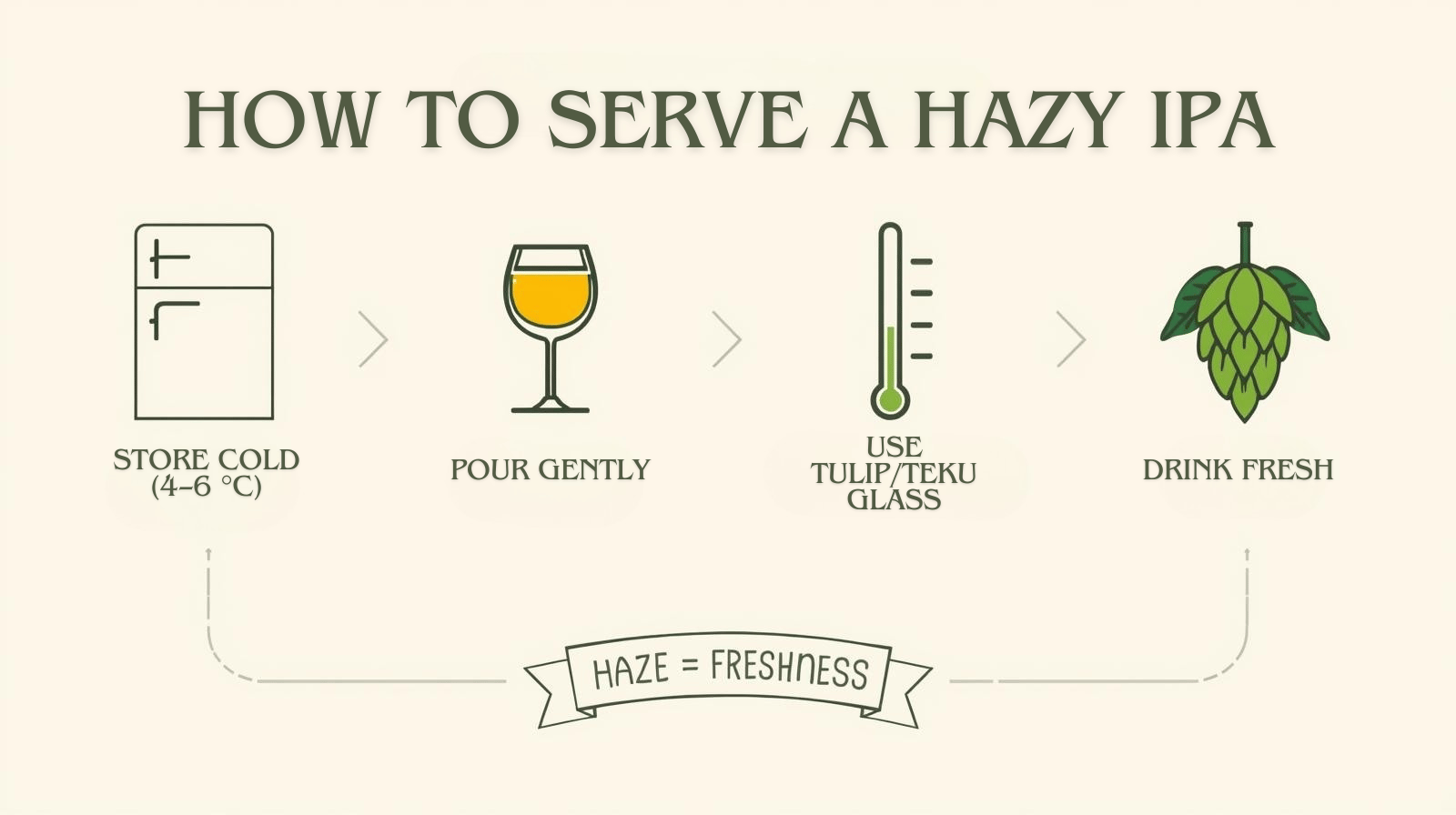
1. Freshness Is Everything
Hazy IPAs are fragile. The compounds that make them juicy and aromatic — hop oils, esters, and volatile thiols — begin to degrade as soon as the beer leaves the tank.
Drink them fresh, ideally within 30 to 60 days of canning.
As BeerAdvocate explains, “Hop-forward beers should be enjoyed as fresh as possible — that’s when their character truly shines.”
So skip the dusty shelf bottles and check the ‘born-on’ date whenever possible.
Treat hazy IPAs more like fresh fruit than wine — they’re meant to be consumed young, vibrant, and alive.
2. Store Cold and Upright
Heat and light are the enemies of haze.
Keep your hazy IPAs refrigerated from the moment you buy them — ideally around 4–6°C (39–43°F).
Avoid temperature swings, which can accelerate oxidation and flatten hop character.
Store cans upright to allow sediment to settle naturally and minimize oxygen contact at the lid.
Never leave them near windows or on a sunny kitchen counter — UV light can cause “skunky” flavours within hours.
3. Pour Gently, Not Perfectly
Contrary to myth, hazy IPAs aren’t meant to be violently swirled or poured like orange juice.
You want the haze, but you don’t need to dump the entire yeast cake into the glass.
Here’s the ideal pour:
- Chill your beer properly (around 7–9°C for serving).
- Use a tulip or Teku glass, which traps aroma while letting the haze shine.
- Pour slowly, leaving the last half-inch of sediment behind unless the brewery specifies otherwise.
- Admire the glow — that opaque, golden storm of hops and proteins.
4. Choose the Right Glassware
Hazy IPAs are all about aroma — and the glass you use matters more than you think.
The tulip and Teku shapes are ideal: both taper toward the rim, concentrating aromas so each sip bursts with tropical intensity.
Avoid pint glasses with wide mouths (they let those precious hop aromas escape too fast).
And always rinse your glass before pouring to remove dust or detergent residue — nothing kills a head faster than soap film.
5. Pair with Bright, Bold Foods
The lush fruitiness of hazy IPAs makes them surprisingly versatile with food.
Try pairing with:
- Spicy tacos or curries – the fruity hops balance heat beautifully.
- Cheddar or blue cheese – the bitterness cuts richness, the sweetness complements.
- Grilled pineapple or mango salsa – echo the tropical notes.
- Fried chicken or burgers – carbonation scrubs away fat, keeping each bite fresh.
For inspiration, see our guide on Perfect Cheese and Beer Pairings (2025 Guide), where tropical hops meet savoury balance.
6. Don’t Age It — Celebrate It
Unlike imperial stouts or barleywines, hazy IPAs don’t improve with age.
The haze may settle, the colour may darken, and the bright hop character will fade.
Even a three-month-old hazy can taste dull, grassy, or oxidized.
Drink them fresh, share them fast, and restock often.
The beauty of haze lies in its impermanence — each can is a fleeting snapshot of freshness.
7. Embrace the Sensory Ritual
Finally, remember: drinking a hazy IPA isn’t just tasting beer — it’s a small sensory ceremony.
The sight of that glowing haze, the burst of fruit aroma, the creamy sip that lingers just long enough — it’s craftsmanship disguised as comfort.
When you slow down and give it your full attention, you’ll start to notice the layers: the mango against the citrus, the oats cushioning the hops, the subtle sweetness balancing the bitter edge.
That’s what turns a good beer into a memorable one — and why the best hazy IPA beers are best enjoyed mindfully, one sip at a time.
🍺 Taste & Travel Like a Beer Pro
Love what you’re reading? Turn inspiration into your next beer adventure:
- 🛒 Beers of Europe – shop iconic craft selections & limited editions
- 🏨 Hotels.com – find cozy stays near top beer festivals
- 🎟️ Viator – join brewery tours & tasting experiences
Plan • Sip • Repeat — your next beer trip starts here.
FAQ — Best Hazy IPA Beers
What makes a Hazy IPA different from a regular IPA?
A Hazy IPA (or New England IPA) is unfiltered and heavily dry-hopped, resulting in a cloudy appearance and juicy flavour.
Unlike West Coast IPAs, hazy IPAs have low bitterness and a soft, fruity aroma.
Why are Hazy IPAs called “juicy”?
The term “juicy” describes the beer’s fruit-forward hop aroma — often evoking mango, orange, and pineapple.
This character comes from late-stage hopping and yeast biotransformation, which releases tropical esters during fermentation.
What causes the haze in Hazy IPAs?
The haze forms from proteins in oats or wheat binding with hop polyphenols.
This creates a stable, cloudy suspension that enhances mouthfeel and aroma.
Are Hazy IPAs less bitter than West Coast IPAs?
Yes. Hazy IPAs emphasize flavour and aroma over bitterness.
They typically range between 20–50 IBU, while West Coast IPAs can exceed 70.
Should I drink Hazy IPAs fresh?
Absolutely. Hazy IPAs lose hop aroma quickly, so drink them within 30–60 days of canning.
Always check packaging dates and store them cold to preserve freshness.
Can you age Hazy IPAs?
No — hazy IPAs are not designed for aging.
With time, hop compounds oxidize and the haze breaks down, leaving muted, grassy flavours.
What’s the best temperature to serve a Hazy IPA?
Serve between 7–9°C (45–48°F) to highlight aroma without dulling flavour.
Colder temperatures can suppress tropical notes; warmer ones accentuate bitterness.
What food pairs best with Hazy IPAs?
Try pairing with spicy foods, strong cheeses, and citrus-forward dishes.
Hazy IPAs’ fruitiness complements heat and cuts through creamy or fried textures.
Why do Hazy IPAs need to be stored cold?
Warm storage accelerates oxidation, dulling hop character and producing stale flavours.
Cold storage preserves the beer’s delicate aroma and haze stability.
What are the best Hazy IPAs available in the UK right now?
Top-rated options include Cloudwater IPA v-series, Verdant Headband, Deya Steady Rolling Man, and Track Sonoma.
These breweries consistently deliver freshness and quality comparable to American icons like Heady Topper and Julius.
Why are Hazy IPAs so popular in 2025?
Drinkers are drawn to their balance of flavour, aroma, and smoothness.
Modern hop technology, creative yeast strains, and social media have all amplified their appeal.
Are all Hazy IPAs the same?
Not at all. Each brewery interprets the style differently — some lean toward citrus, others toward stone fruit or pine.
That variety is what keeps the haze scene exciting and ever-changing.
Can lactose or fruit be used in Hazy IPAs?
Yes. Some brewers use lactose for creaminess or fruit purées for added depth — often called milkshake or smoothie IPAs.
These are modern, dessert-inspired variations on the hazy style.
What’s the ideal glass for a Hazy IPA?
Use a tulip or Teku glass to capture aroma and showcase the haze.
These shapes focus the bouquet while maintaining a thick, lasting head.
Can homebrewers make Hazy IPAs easily?
Yes — the Brew-In-A-Bag (BIAB) method makes it accessible for homebrewers.
Using oats, late dry-hopping, and proper temperature control yields excellent results.
What should you avoid when brewing or buying a Hazy IPA?
Avoid oxidized or old cans, beers stored warm, and over-shaken cans that disturb sediment.
Look for cold storage and recent packaging dates to ensure maximum flavour.
The beauty of the haze lies in its contradiction — bold yet soft, cloudy yet radiant, fleeting yet unforgettable.
Every great hazy IPA captures a moment: the first citrus burst when you crack the can, the glowing glass in afternoon light, the quiet satisfaction of that last tropical sip.
By now, you’ve explored the style’s history, science, and the brewers shaping its future.
You’ve met legends like Heady Topper and Julius, discovered new UK favourites from Cloudwater, Verdant, and Deya, and learned how to enjoy each pour at its freshest.
But the real joy of beer — and especially of the best hazy IPA beers — isn’t in the list itself.
It’s in chasing the freshness, supporting the breweries that make it possible, and finding that one hazy IPA that speaks to your own palate.
So go ahead:
Seek out something new this weekend. Visit a taproom. Order a mixed case.
Pour it slowly, take in the aroma, and share it with someone who hasn’t yet tasted what “juicy” really means.

And when you find your new favourite haze, come back to BeerMadness.com — tell us what you discovered, explore more guides, and keep your glass full of curiosity. 🍺
🍻 More from BeerMadness
Keep exploring the world of craft beer — one pour at a time.
Because in the end, beer isn’t just brewed — it’s experienced.

